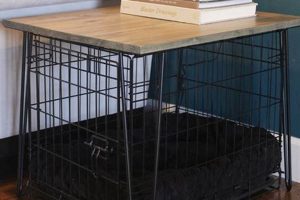A do-it-yourself solution created to aid canines in accessing boats, this structure typically features a sloping plane that extends from the water level to the boat deck. Such a device allows dogs of all sizes and abilities to enter and exit watercraft independently, enhancing their safety and the convenience of boating activities. Construction materials can range from wood and metal to durable plastics, often incorporating non-slip surfaces to prevent accidents.
The creation of such an apparatus provides several key advantages. It enhances canine safety by minimizing the risk of falls or struggles while boarding or disembarking. Furthermore, it promotes canine independence, allowing pets to move freely without constant assistance from their owners. Historically, pet owners have sought innovative solutions to improve their animals’ quality of life, and this represents a continuation of that trend, focusing on water-based recreational activities.
The following sections will detail considerations for designing and building such a structure. Topics covered will include material selection, construction techniques, safety considerations, and adaptations for various boat types and dog breeds. A focus will be maintained on creating a durable, safe, and user-friendly solution for both the canine and their owner.
Construction and Usage Guidelines
This section offers essential guidance for the creation and implementation of a canine watercraft access platform, emphasizing safety and durability.
Tip 1: Material Selection: Opt for marine-grade plywood or treated lumber for enhanced water resistance. Corrosion-resistant hardware, such as stainless steel screws and bolts, will prolong the structure’s lifespan. Avoid pressure-treated lumber containing chromated copper arsenate (CCA) due to potential toxicity concerns.
Tip 2: Ramp Angle: Design the incline to be gradual, minimizing strain on the animal’s joints. A steeper angle increases the risk of slips and falls, especially for older or less agile dogs. Consider the breed and size of the dog when determining the optimal angle.
Tip 3: Surface Traction: Apply a non-slip coating, such as marine-grade anti-skid paint or adhesive grip tape, to the ramp surface. Regularly inspect and replace worn or damaged traction materials to maintain safety.
Tip 4: Flotation: Integrate buoyant elements, such as closed-cell foam or sealed plastic containers, to ensure the platform remains stable and partially submerged. This assists the animal in transitioning from the water to the ramp.
Tip 5: Secure Attachment: Implement a robust attachment system that securely connects the ramp to the boat. Utilize adjustable straps, hooks, or clamps to accommodate varying boat designs. Regularly inspect the attachment points for wear and tear.
Tip 6: Training and Acclimation: Introduce the animal to the apparatus gradually, using positive reinforcement techniques. Begin with short training sessions in a calm environment before attempting use on the water. Observe the animal’s comfort level and adjust the training accordingly.
Tip 7: Weight Capacity: Engineer the structure to support the weight of the largest potential user. Over-engineering provides an added safety margin and ensures the platform’s longevity. Consult load-bearing tables for specific material specifications.
Adherence to these guidelines will result in a safer and more effective solution for canine water access, enhancing the overall boating experience.
The subsequent section will address common challenges encountered during construction and provide troubleshooting strategies.
1. Stability
Stability is a paramount consideration in the design and construction of a do-it-yourself canine watercraft access device. The inherent instability of a floating environment necessitates a structure that minimizes the risk of tipping or wobbling, ensuring the animal’s safety and confidence.
- Flotation Integration
The inclusion of buoyant elements, such as sealed foam or air-filled chambers, is critical to counteract the device’s weight and maintain a stable platform. The volume and placement of these elements must be carefully calculated to achieve adequate buoyancy and prevent submersion or tilting. An underestimation of buoyancy can lead to complete submersion of the ramp, rendering it unusable, while uneven distribution can cause instability and potential injury.
- Center of Gravity
The distribution of weight within the structure significantly impacts its stability. A lower center of gravity enhances stability by reducing the leverage that external forces, such as waves or the dog’s movement, can exert. Designers should aim to concentrate heavier materials towards the bottom of the structure and avoid top-heavy designs.
- Base Width and Support
The width of the ramp’s base where it contacts the water influences its resistance to tipping. A wider base provides greater stability by distributing the load over a larger area. Additionally, incorporating supporting elements, such as outriggers or pontoons, can further enhance stability, particularly in choppy water conditions. The width of the base and any supporting structures must be proportionate to the expected load and environmental conditions.
- Connection to the Boat
The method of attachment to the boat directly affects the overall stability of the setup. A secure and rigid connection minimizes movement and prevents the ramp from detaching or shifting, which could destabilize the platform and potentially cause the dog to fall. Attachment points should be robust and designed to withstand the forces exerted by the dog’s weight, wave action, and boat movement. Flexible connections may introduce excessive movement and compromise stability.
Achieving adequate stability requires careful planning and execution. Failure to address these facets can result in a hazardous device that increases the risk of accidents and discourages canine use. Prioritizing stability ensures a safe and reliable means for dogs to access watercraft, enhancing their enjoyment and the overall boating experience.
2. Material Durability
The longevity and safety of a do-it-yourself canine watercraft access device are inextricably linked to the selection of appropriate construction materials. Material durability directly impacts the structure’s ability to withstand the rigors of a marine environment, including constant exposure to water, sunlight, and the physical stresses imposed by canine use. Inferior materials degrade rapidly, compromising structural integrity and increasing the risk of failure, which can lead to potential injury for the animal.
Consider the ramifications of using untreated wood versus marine-grade plywood. Untreated wood absorbs water, leading to rot, warping, and eventual structural collapse. In contrast, marine-grade plywood is manufactured with waterproof adhesives and is more resistant to water damage, significantly extending the ramp’s lifespan. Similarly, utilizing galvanized steel hardware instead of standard steel prevents corrosion, maintaining the strength of connections and preventing rust-related failures. The selection of durable, weather-resistant materials is not merely a matter of aesthetics; it is a critical safety consideration.
Therefore, investing in high-quality, durable materials is paramount in creating a safe and effective canine watercraft access solution. While initial costs may be higher, the long-term benefits of reduced maintenance, increased lifespan, and enhanced safety far outweigh the initial investment. Compromising on material quality compromises the entire project, potentially endangering the animal and negating the purpose of the device. Proper material selection ensures the structure remains a reliable and safe asset for years to come.
3. Ramp Inclination
Ramp inclination is a critical design parameter in the construction of a do-it-yourself canine watercraft access ramp. The angle of the ramp significantly affects the ease and safety with which a dog can ascend or descend, directly influencing the device’s usability. A steep incline necessitates greater physical exertion, potentially causing strain or injury, particularly for older dogs or those with joint problems. Conversely, an excessively shallow incline extends the ramp’s length, increasing its footprint and potentially rendering it unwieldy or impractical for certain boat configurations. Real-world examples demonstrate the impact: a ramp with a 45-degree angle might be impassable for a small breed, while a 15-degree angle could extend several feet, obstructing boat traffic. Proper inclination is essential for safe and effective operation.
The optimal ramp inclination is contingent upon several factors, including the dog’s breed, size, age, and physical condition. Smaller breeds or dogs with mobility limitations typically require gentler slopes. Larger breeds may tolerate steeper inclines, but safety should still be prioritized. Adjustable ramps, allowing for variable inclination, offer a versatile solution catering to diverse canine needs. Field testing, with observation of the dog’s gait and comfort level, is crucial in determining the most suitable angle. The construction should, ideally, accommodate adjustments to the angle, allowing the user to optimize the ramp for particular canine limitations or capabilities. Neglecting to customize the inclination can render the device ineffective or, worse, create a safety hazard.
In conclusion, ramp inclination represents a key element in the effective design and implementation of canine watercraft access structures. Addressing this design parameter carefully enhances usability, safety, and ultimately, the value of the ramp. Challenges associated with determining the optimal inclination can be mitigated through careful consideration of the dogs physical attributes and adaptability. Thoughtful integration of an adjustable system ensures broad application.
4. Surface Traction
Surface traction represents a critical safety component in the design and implementation of a do-it-yourself canine watercraft access ramp. Insufficient traction on the ramp surface directly increases the risk of slips, falls, and potential injuries for the dog, particularly in wet conditions. The connection between surface traction and the ramp’s functionality is causal: inadequate traction negates the ramp’s intended purpose of providing safe and easy access to the boat. Without sufficient grip, the ramp becomes a hazard rather than an aid. For instance, a smooth wooden surface, when wet, provides minimal traction, making it difficult for a dog to maintain its footing, especially when transitioning from the water or during boat movement. Consequently, the dog may hesitate to use the ramp, diminishing its value.
The practical significance of understanding and addressing surface traction lies in preventing accidents and encouraging the dog’s confident use of the ramp. Various materials and techniques can enhance surface traction, including marine-grade anti-skid paint, adhesive grip tape, or grooved surfaces. The selection of the appropriate material depends on factors such as durability, cost, and ease of application. Real-world applications involve applying non-slip coatings to wooden or metal ramps, creating a textured surface that provides a secure grip. Regularly inspecting and maintaining the surface traction is crucial to ensure its continued effectiveness. A worn or damaged surface loses its grip, increasing the risk of slippage. Implementing a proactive maintenance schedule extends the ramp’s usability and reduces potential hazards.
In summary, surface traction is an indispensable element of a canine watercraft access ramp, directly impacting canine safety and the ramp’s overall effectiveness. Understanding the connection between surface traction and potential risks enables builders to incorporate appropriate materials and techniques, creating a secure and reliable access solution. The ongoing challenge lies in selecting durable, cost-effective materials that maintain their grip over time and withstand the harsh marine environment. Addressing this issue proactively ensures the ramp remains a valuable asset, promoting canine well-being and enhancing the enjoyment of boating activities.
5. Attachment Security
Attachment security is a foundational element in the functionality and safety of any do-it-yourself canine watercraft access ramp. The integrity of the connection between the ramp and the boat directly influences the stability and reliability of the entire system. A compromised attachment can lead to sudden detachment, causing the dog to fall into the water, potentially resulting in injury or panic. The causal relationship is clear: inadequate attachment security inevitably leads to an unsafe and unusable ramp. For instance, a ramp secured only with flimsy ropes may become detached during boat movement or when the dog applies its weight, rendering the device ineffective and dangerous.
The importance of attachment security stems from its direct impact on the canine’s well-being and the device’s operational effectiveness. A robust attachment system must withstand the dynamic forces exerted by the dog’s weight, wave action, and boat movement. Examples of secure attachment methods include using adjustable straps with heavy-duty buckles, clamps specifically designed for marine environments, or custom-engineered brackets that securely interface with the boat’s hull. These methods ensure a stable and reliable connection, minimizing the risk of detachment and providing a safe platform for the dog. The practical significance of understanding attachment security lies in preventing accidents and fostering the dog’s confidence in using the ramp.
In summary, attachment security is an indispensable aspect of any do-it-yourself canine watercraft access solution. Failure to adequately address this element undermines the entire project, potentially jeopardizing the animal’s safety. The key insight is that a secure attachment is not merely a desirable feature but a fundamental requirement for creating a reliable and safe access ramp. Challenges related to attachment security can be mitigated by selecting appropriate hardware, implementing robust connection methods, and regularly inspecting the attachment points for wear and tear. By prioritizing attachment security, builders can ensure that the ramp provides a safe and reliable means for dogs to access watercraft, enhancing their boating experience and promoting their well-being.
6. Weight Capacity
Weight capacity represents a critical engineering parameter in the design and construction of a do-it-yourself canine watercraft access ramp. This factor dictates the maximum load the structure can safely bear without compromising its structural integrity or posing a risk to the user. Underestimation of the appropriate weight capacity can lead to catastrophic failure, potentially resulting in injury to the animal.
- Material Selection and Load-Bearing Capabilities
The choice of materials directly influences the ramp’s weight capacity. Different materials possess varying load-bearing capabilities, measured in terms of tensile strength, compressive strength, and flexural strength. For instance, marine-grade plywood exhibits greater structural strength compared to standard lumber, enabling it to support heavier loads. Understanding the load-bearing characteristics of each material is crucial for selecting appropriate components that meet the required weight capacity. Real-world examples include using thicker plywood sheets or incorporating reinforcing members to enhance load-bearing capabilities.
- Structural Design and Load Distribution
The structural design of the ramp significantly impacts its ability to distribute weight effectively. A well-designed structure distributes the load evenly across its various components, minimizing stress concentrations and preventing localized failures. Incorporating support beams, cross-bracing, or strategically placed reinforcements enhances the ramp’s overall stability and load-bearing capacity. Inefficient load distribution can lead to premature failure, even if the materials themselves possess adequate strength. Examples include designing a ramp with evenly spaced support beams to distribute the weight of the dog across the entire structure.
- Environmental Factors and Safety Margins
Environmental factors, such as wave action and moisture exposure, can degrade the materials and reduce the ramp’s weight capacity over time. Therefore, incorporating a safety margin into the design is essential to account for potential degradation and ensure the structure remains safe even under adverse conditions. A common practice is to design the ramp to withstand a load significantly greater than the expected maximum weight. This safety margin provides a buffer against unexpected stresses or material degradation. Examples include designing the ramp to support twice the weight of the largest potential user.
- Fastener Selection and Connection Strength
The strength of the connections between various components is equally important as the strength of the materials themselves. Fasteners, such as screws, bolts, and adhesives, must be capable of withstanding the stresses imposed by the load and environmental factors. Using corrosion-resistant fasteners is crucial to prevent degradation and maintain the connection strength over time. Examples include using stainless steel bolts and marine-grade adhesives to ensure durable and reliable connections.
In conclusion, weight capacity is a critical consideration in the design and construction of a do-it-yourself canine watercraft access ramp. Accurate assessment of the maximum load, selection of appropriate materials, and implementation of a robust structural design are essential for ensuring the ramp’s safety and reliability. Incorporating a safety margin and regularly inspecting the structure for signs of degradation or damage are crucial for maintaining its long-term performance. By prioritizing weight capacity, builders can create a safe and reliable access solution that enhances the enjoyment of boating activities for both the canine and their owner.
Frequently Asked Questions
This section addresses common inquiries regarding the construction and utilization of a canine watercraft access device, providing informative and technically accurate responses.
Question 1: What constitutes a suitable material for constructing a platform intended for canine use on a marine vessel?
Marine-grade plywood or treated lumber is recommended due to its resistance to water damage and structural integrity. Hardware must be corrosion-resistant, such as stainless steel, to prevent degradation in a marine environment. Avoid materials treated with chromated copper arsenate (CCA) due to potential toxicity.
Question 2: How does one determine the optimal angle of inclination for a structure designed to facilitate canine access to a watercraft?
The angle of inclination should be gradual to minimize strain on the canine’s joints. Consider the dog’s breed, size, and age when determining the angle. A steeper angle increases the risk of slips and falls, while a shallower angle extends the ramp’s overall length. Adjustable ramps offer a versatile solution.
Question 3: What methods are effective in providing adequate traction on a surface designed for canine ambulation in a marine setting?
Marine-grade anti-skid paint, adhesive grip tape, or grooved surfaces enhance traction. Regularly inspect and replace worn or damaged traction materials. The chosen method should provide a secure grip even when wet.
Question 4: What measures should be taken to ensure the structure remains buoyant and stable in aquatic conditions?
Integrate buoyant elements, such as closed-cell foam or sealed plastic containers, to ensure the platform remains stable and partially submerged. Calculate the volume and placement of these elements to achieve adequate buoyancy and prevent submersion or tilting.
Question 5: What constitutes a secure and reliable attachment mechanism for connecting the structure to a watercraft?
Adjustable straps, hooks, or clamps should be utilized to accommodate varying boat designs. The attachment system must be robust and capable of withstanding the forces exerted by the dog’s weight, wave action, and boat movement. Regularly inspect the attachment points for wear and tear.
Question 6: How does one ascertain the appropriate load-bearing capacity for such a structure to ensure canine safety?
Engineer the structure to support the weight of the largest potential user, incorporating a safety margin. Consult load-bearing tables for specific material specifications. The design should account for environmental factors, such as wave action, which can increase stress on the structure.
Adherence to these guidelines ensures a safer and more effective solution for canine water access, enhancing the overall boating experience.
The next section will present a detailed construction guide with step-by-step instructions.
Conclusion
This exploration of the “diy dog boat ramp” concept has underscored the importance of careful design and construction to ensure both canine safety and device longevity. Crucial elements such as material durability, ramp inclination, surface traction, attachment security, and weight capacity have been thoroughly addressed, providing a comprehensive foundation for successful implementation. The information presented serves to empower individuals seeking a practical and safe solution for facilitating canine watercraft access.
The successful creation and deployment of a “diy dog boat ramp” necessitates meticulous attention to detail and a commitment to safety protocols. The information provided is intended to serve as a guide for responsible construction and utilization. By adhering to established guidelines, individuals can significantly enhance the well-being of their canine companions while enjoying water-based activities. Further research and adaptation to specific circumstances are encouraged to optimize performance and ensure a safe and enjoyable experience for all.






![Build a Safe Sliding Dog Gate DIY [Easy Steps!] The DIY Hub: Creative Crafts, Repairs & Life Hacks Build a Safe Sliding Dog Gate DIY [Easy Steps!] | The DIY Hub: Creative Crafts, Repairs & Life Hacks](https://craftingdiycenter.com/wp-content/uploads/2025/07/th-2861-300x200.jpg)
